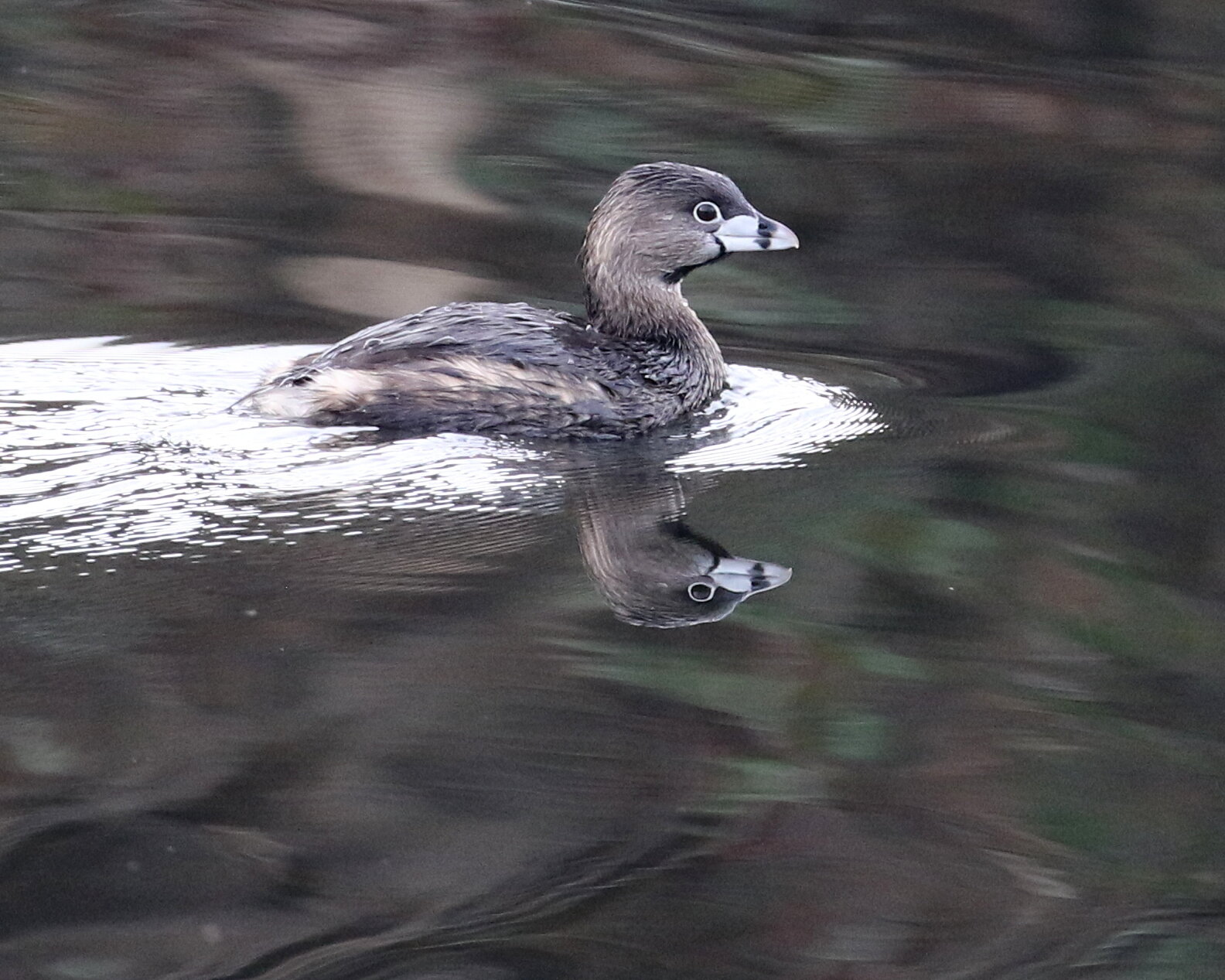This area is located on the north bank of the American River, bordered on the east and south by the river and on the north by a man-made levee. The habitat consists mostly of riparian woodlands found adjacent to the river and dominated by Fremont cottonwood, white alder, California sycamore, California black walnut, and several willow species. A large pond is located toward the southern edge of the area, with a large expanse of open habitat at the center. A developed park generally runs through the northern part of the area separated from the natural areas by the bicycle trail with a stand of eucalyptus trees bordering the levee. William B. Pond Recreation Area supports a diverse set of conditions with a good variety of both plant and animal life. Visitors can take a variety of trails throughout the area to search for wildlife.
Pied-billed Grebe, Image by Chris Conard
Birding the site: On fast flowing water where riffles are present, look for Common Goldeneye and Common Merganser. On quiet waters look for Pied-billed Grebe, Double-crested Cormorant, Canada Goose and Mallard. Along the shoreline look for Great Blue Heron, Great Egret, Snowy Egret, Green Heron, Killdeer, Greater Yellowlegs and Spotted Sandpiper. Watch for Osprey perched on dead snags or Black Phoebe fly-catching low over the river. Listen for the rattle call of the Belted Kingfisher as it forages for fish in the river.
The ponds within William B. Pond Recreation Area are home to Pied-billed Grebe, Canada Goose, Mallard, Wood Duck, Double-crested Cormorant, Green Heron and, during the winter, American Coot. A patient observer may locate beaver in the early morning or late evening, or muskrat and river otter during the day. There are several beaver lodges located against the banks of the river, as well as in the ponds. A Great Blue Heron and Great Egret nesting rookery is located east of the large pond with a lot of activity being observed between March and May.
From October through April, heavy concentrations of Turkey Vulture, American Herring Gull, California Gull and Ring-billed Gull can be observed on gravel bars near riffles where salmon have died after their struggle to reach their breeding grounds. In addition, an observer may see Forster’s Terns in April and May. Cliff Swallows build gourd-like nests of mud on the bicycle bridge that spans the American River.
Sandy banks and cliffs along the river’s edge make good nesting holes for Belted Kingfisher and Northern Rough-winged Swallow. In the riparian corridor along the river’s edge, look for Red-shouldered Hawk and Cooper’s Hawk, Anna’s Hummingbird, Nuttall’s Woodpecker and Downy Woodpecker, Ash-throated Flycatcher, Black Phoebe, Oak Titmouse, White-breasted Nuthatch, Bushtit, Bewick’s Wren, and Northern House Wren, California Scrub-Jay, Hermit Thrush, Spotted Towhee, and, in winter, Yellow-rumped Warbler, Fox Sparrow, and Lincoln’s Sparrow. Watch for western gray squirrel in the Fremont cottonwoods, California black walnut and the scattered valley oak and interior live oak of the riparian woodlands, as well as black-tailed deer in the understory near blackberry brambles.
In the open areas and the edges of woodlands, look for Turkey Vulture, White-tailed Kite, American Kestrel, Mourning Dove, Western Kingbird, Western Bluebird, California Towhee, both Lesser and American Goldfinch, as well as desert cottontail and black-tailed jackrabbit. Western Bluebird, American Crow, Yellow-billed Magpie, and House Finch are located in the developed park as well as western gray squirrel and eastern fox squirrel. eBird Sightings
You can read more about the accessible features of this locations on our Accessible Birding page.
William B. Pond Recreation Area Trail Map
Directions: From downtown Sacramento, take Highway 50 east for 7.0 miles from Interstate 5, and take the Watt Avenue exit north. Proceed 1.6 miles north to Fair Oaks Boulevard and head east for 2.5 miles to Arden Way. Turn right and go 0.7 mile to the entrance and fee station. The American River Bike Trail crosses from River Bend Park (formerly C.M. Goethe Park) on the south side via the Harold Richey Memorial Bridge and generally runs through the northern edges of the area before turning southwest toward the large pond and then downriver toward Watt Avenue. The entrance fee is currently $7 per vehicle (or a $70 annual pass).
Dave Johnson

